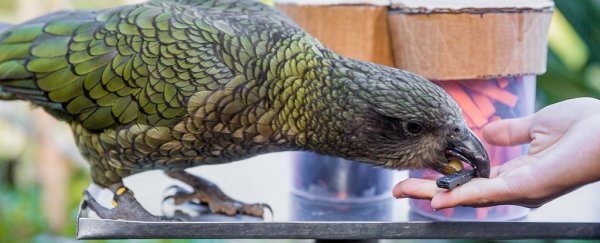Up until now, only human beings and other great apes have demonstrated an ability to understand probabilities – being able to weigh up the odds based on the available data, or statistical inference, as it's formally called. Now, for the first time, a parrot species has demonstrated this skill.
Tests on six kea (Nestor notabilis) parrots have shown they were able to understand and act on probabilities in a variety of scenarios that have previously been tested on humans and apes.
The findings have some wide-reaching implications – from understanding more about how the minds of non-primates might work, to producing more realistic and detailed artificial intelligence systems of our own.
In particular, the result sheds some light on whether human and non-human brains tend to develop specific sections for specific tasks (domain-specific), or adapt the same sort of cognitive processes for whatever task is required (domain-general).
"Our results show that kea exhibit three signatures of statistical inference, and therefore can integrate knowledge across different cognitive domains to flexibly adjust their predictions of sampling events," the researchers write in their newly published study.
"This result provides evidence that true statistical inference is found outside of the great apes, and that aspects of domain-general thinking can convergently evolve in brains with a highly different structure from primates."
The study played out over three experiments. Six kea – Blofeld, Bruce, Loki, Neo, Plankton and Taz – were first trained to associate the colour black with a reward, and the colour orange with no reward.
After filling up transparent jars with differing levels of black and orange tokens, the researchers would pick tokens from one or two jars in front of the parrot, conceling the token colour and letting the parrots make a choice from a closed hand.
The kea showed a preference for choosing a hand that held a token picked from the jar with the highest proportion of black tokens: hence, the highest probability of getting a reward.
The birds weren't as swayed by the jars that had most black tokens or the fewest orange tokens in total in them – only the jars that had more black tokens in relation to the number of orange tokens.
When physical barriers were placed in the jars, changing the fraction of rewarding tokens that could be accessed, the parrots changed their behaviour accordingly.
 A kea parrot and sample jars. (Amalia Bastos)
A kea parrot and sample jars. (Amalia Bastos)
Finally, the birds also showed a tendency to favour the human experimenters with more of a 'bias' of giving out rewarding tokens in the past.
Taken together, all of these experimental results show the complex cognitive processes of statistical inference in action.
Similar sorts of experiments have been done on human infants and great apes in the past, and the signs are that parrots have the same sort of mental agility.
We'll need more research to figure out how animal brains process these probabilities, but considering we last shared a common ancestor with birds some 312 million years ago, the ability may have evolved more than once.
"This has important implications not only for our understanding of how intelligence evolves, but also for research focused on how to create artificial domain-general thought processes," conclude the researchers.
The research has been published in Nature Communications.
